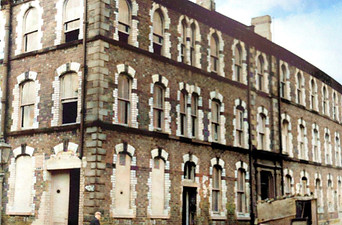Save Havelock House

The Early Years
Havelock House was built at time when not just television but even moving pictures seemed to be an unattainable dream.
It was built in 1871 by James Thompson & Sons, a small but wealthy firm which specialised in producing fine handkerchiefs for export.
It acted as the company's headquarters, acting as a combined factory, warehouse and offices. Its exterior consisted of fine yellow brickwork finished with decorative polychrome patterns highlighting key architectural features.
The exterior is currently hidden by plaster rendering, applied by UTV in 1959 to give the building a more contemporary appearance.
Trouble with the Gasworks
Although Thompsons was a niche manufacturer, demand for its goods steadily as Belfast experienced a linen boom. By the 1900s, the main threat to its business wasn't a competitor but its neighbour - the Belfast Gasworks.
Since Havelock House was built, the Gasworks had expanded rapidly. Its site had increased ten-fold, leading to a massive increase in air pollution.
While local residents complained, Belfast Corporate was reluctant to pay for improvements as it was reliant on profits from the Gasworks to fund projects such as Belfast City Hall.
By 1902, the pollution had become so bad that soot often rained down on the Ormeau Road. It even penetrated inside buildings, posing problems for local businesses.
Thompsons was particularly badly affected because the soot soiled the company's products as they sat in its warehouse. A contemporary account records:
"The frequency and constancy with which valuable articles were destroyed made it impossible for [the company] to continue... if the present state of things went on.
Goods had to be washed over and over again, but, in spite of every precaution, they were utterly destroyed."
The company's complaints were ignored by the Corporation until Thompsons sought a court order preventing the production of gas.
The case was heard at Dublin's High Court in June 1904. It proved highly embarrassing for the Corporation as a steam of local residents testified as witnesses about the impact that the pollution had on their lives.
The court granted the order sought by Thompsons and Belfast Corporation was forced to change how it produced gas.
Life after linen
While the Gasworks didn't put an end to linen production at Havelock House, the Great Depression did and James Thompson & Sons went into liquidation in 1932.
The building soon became the headquarters for Batty Brothers, a tea merchant which also operated the successful Green and White stamps scheme. The stamps were given with purchases by shopkeepers and could, when enough were collected, be exchanged for a 'free' gift. The idea was to encourage customer loyalty.
The company boasted that Havelock House was "the most spacious establishment of its kind in the country". The ground floor was used for offices and gift showrooms while the upper floors contained packing and storage departments.
In 1940, the building was requisitioned by the British Government for wartime service. It was originally intended to be used as a reception centre for Belgian refugees.
This never happened and the building was given to the British Army where it was used as billet for soldiers defending Belfast. It also appears to have been used as a supply depot.
After the war, the building was purchased by J.M. Ritchie, a maker of ladies dresses and blouses, which was facing growing demand for its products that it had been unable to meet.
It appears that this upsurge in demand didn't last too long as, in just over a decade, Ritchie's decided to put Havelock House back on the market. Although it was advertised as a warehouse/factory, the building's next owners had very different ideas...

The original decorative exterior of Havelock House seen in the late 1950s - it still survives under plaster render

The Thompson's case against Belfast Corporation was an important news story given the stakes involved.
Inside the linen factory
Evidence from the court case provides an overview of Thompsons' operations in 1904.
The business was "primarily concerned with the bleaching and finishing of the finest kinds of linen goods". It mainly produced handkerchiefs at the rate of 600 per day.
The linen was bleached, then pleated and finished before being cut into shape for handkerchiefs and sent out to sales agents.
The building also housed a laundry where goods were cleaned before final dispatch.

Havelock House as depicted in a Batty Brothers advertisement from 1935

An October 1958 auction notice for Havelock House. The building wasn't sold on that occasion (click for a closer look)